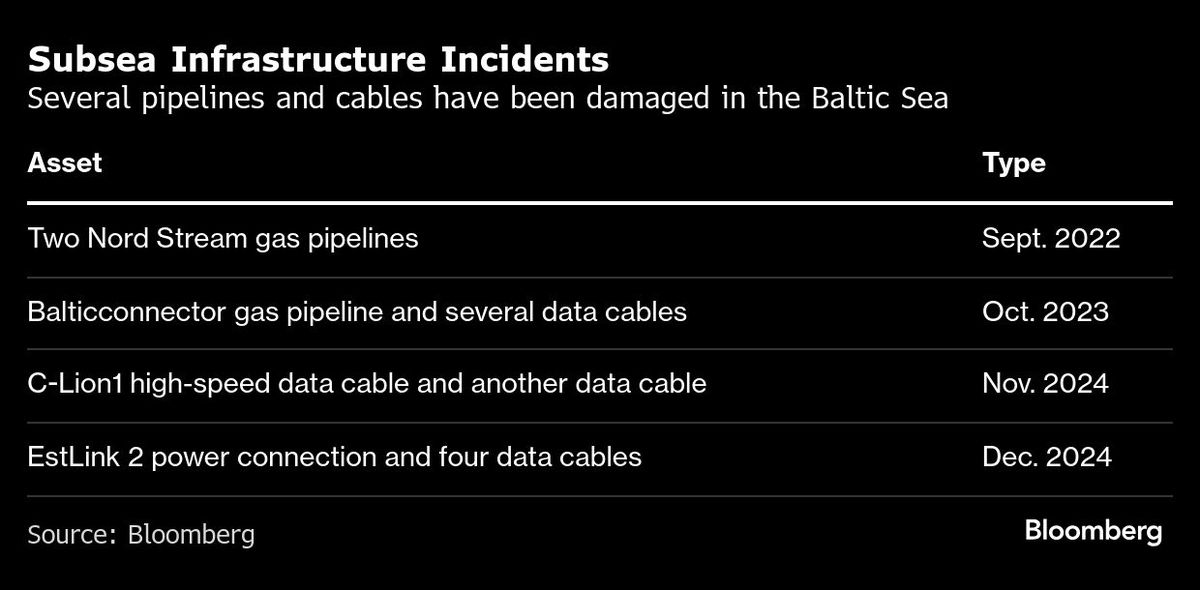
(Jan 14): The European Union’s new digital chief, Henna Virkkunen, suggested the repeated damage to undersea cables in the Baltic Sea couldn’t be fully accidental, as leaders from the region prepare to gather for a Nato summit devoted to the topic.
“It can’t really be by accident if these are happening many times a year,” Virkkunen, the European Commission’s executive vice president for technological sovereignty, security and democracy, told Bloomberg TV in an interview taped on Monday.
There have been three instances of suspected sabotage of underwater power lines, data cables and a gas pipeline over the past 15 months in the Baltic Sea, with ship anchors tearing the infrastructure from the seabed.
On Tuesday, officials from the EU and North Atlantic Treaty Organization gathered for a meeting with leaders from countries surrounding the Baltic Sea in Helsinki to address “how we can better prevent and detect and also respond to that kind of incidents,” Virkkunen added. The summit is co-hosted by Finland and Estonia.
Arriving in Helsinki, Lithuanian President Gitanas Nauseda said three “violations” in such a short period of time “shows that this is not an accident and that there is a very high probability that those are deliberate actions of hostile countries.”
Authorities have established no motivation for the three incidents, involving ships flagged in Hong Kong, China and the Cook Islands, with anchor drag marks discovered over long distances on the bottom of the sea.
“There have been accidents and we have to assume that they are part of a hybrid strategy to threaten European countries,” German Chancellor Olaf Scholz said. Germany will respond with increased surveillance patrols by the navy, he said.
Scholz said attacks on infrastructure “cannot be ignored and are a serious threat.”
Following suspected sabotage of undersea cables between Finland and Estonia, Nato is increasing its surveillance operations in the Baltic Sea region by deploying two ships in the area, Finnish Foreign Minister Elina Valtonen announced Friday. Estonia has already sent a warship to patrol another power link.
There’s more that can be done on hybrid threats, of which the cable breaks are the latest example, Nato Secretary General Mark Rutte said at the European Parliament on Monday, adding that allied leaders will take further steps. “We must be more resilient to such hostile actions,” he said.
Finland is investigating the anchor of tanker Eagle S retrieved from the seabed as it probes aggravated criminal mischief and aggravated interference of communications in the cable breach incident that happened in late December. The vessel, sailing under the Cook Islands flag, is believed to have dragged its anchor for long distances.
Officials have identified it as a member of the so-called shadow fleet transporting Russian petroleum products.
The shadow fleet “is one of the ways for Russia to continue the war in Europe,” Danish Prime Minister Mette Frederiksen said as she arrived at the meeting. “We have to be very direct to other countries that we will not accept any kind of sabotage.”
In December, the EU adopted a 15th package of sanctions, this time targeting the shadow fleet of tankers Russia is using to get its oil to market to curb Moscow’s ability to circumvent existing restrictive measures.
“One very efficient measure for the EU is to continue to sanction the Russian shadow fleet,” Latvian President Edgars Rinkevics said, adding that the EU is lagging behind the US and UK in enacting such measures. “We actually need to close the Baltic Sea for the shadow fleet, through the sanctions, through the countermeasures and international law.”
Uploaded by Chng Shear Lane

